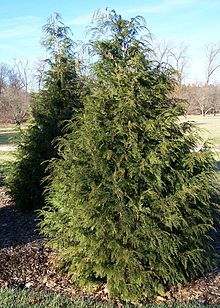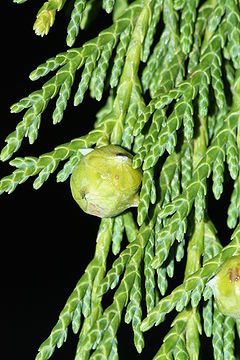- Callitropsis nootkatensis
-
Callitropsis nootkatensis Foliage and green cone, Mount Rainier National Park Conservation status Scientific classification Kingdom: Plantae Division: Pinophyta Class: Pinopsida Order: Pinales Family: Cupressaceae Genus: Callitropsis Species: C. nootkatensis Binomial name Callitropsis nootkatensis
(D.Don) FlorinNootka Cypress (Callitropsis nootkatensis (D. Spach)), formerly Cupressus nootkatensis, Xanthocyparis nootkatensis or Chamaecyparis nootkatensis, is a cypress (Cupressaceae) with a chequered taxonomic and nomenclatural history. This species goes by many common names including Nootka Cypress, Yellow Cypress, and Alaska Cypress. Even though it is not a true cedar, it is also often confusingly called "Nootka Cedar", "Yellow Cedar", "Alaska Cedar", or even "Alaska Yellow Cedar". Its name derives from its discovery on the lands of a First Nation of Canada, the Nuu-chah-nulth of Vancouver Island, British Columbia, who were formerly referred to as the Nootka.
Contents
Taxonomy
First described in the genus Cupressus as Cupressus nootkatensis in 1824, it was transferred to Chamaecyparis in 1841 on the basis of its foliage being in flattened sprays, as in other Chamaecyparis, but unlike most (though not all) other Cupressus species.
However, this placement does not fit with the morphology and phenology of the cones, which are far more like Cupressus, like them maturing in two years, not one. Genetic evidence, published by Gadek et al. (2000), strongly supported its return to Cupressus and exclusion from Chamaecyparis.
More recently, Farjon et al. (2002) transferred it to a new genus Xanthocyparis, together with the newly discovered Vietnamese Golden Cypress Xanthocyparis vietnamensis; this species is remarkably similar to Nootka Cypress and the treatment has many arguments in its favour, as while they are not related to Chamaecyparis, neither do they fit fully in Cupressus despite the many similarities.
Little et al. (2004), while confirming the above relationship with further evidence, pointed out that an earlier nomenclatural combination in the genus Callitropsis existed, as Callitropsis nootkatensis (D.Don) Oerst., published in 1864 but overlooked or ignored by other subsequent authors. Little et al. therefore synonymised Xanthocyparis with Callitropsis, the correct name for these species under the ICBN when treated in a distinct genus. The name Xanthocyparis has now been proposed for conservation, but until that is decided on at the 2011 International Botanical Congress, it is correctly classified in Callitropsis.
Although acceptance of the revised classification of this tree is widespread among botanists, inertia in the horticultural and forestry industries (both typically very slow to adopt the results of botanical research), mean the name Chamaecyparis nootkatensis is likely to continue being listed in many situations.
Description
Nootka Cypress is native to the west coast of North America, from the Kenai Peninsula in Alaska, south to the Klamath Mountains in northernmost California. It is typically occurring on wet sites in mountains, often close to the tree line, but sometimes also at lower altitudes.
Callitropsis nootkatensis is an evergreen tree to 40 m tall, commonly with pendulous branches. The foliage is in flat sprays, with dark green, 3–5 mm long scale-leaves. The cones have 4 (occasionally 6) scales, and resemble the cones of Mexican Cypress (Cupressus lusitanica, another Cupressus species which can show foliage in flat sprays) fairly closely, except being somewhat smaller, typically 10–14 mm diameter; each scale has a pointed triangular bract about 1.5–2 mm long, again similar to other Cupressus and unlike the crescent-shaped, non-pointed bract on the scales of Chamaecyparis cones. The Caren Range on the west coast of British Columbia is home to the oldest Nootka Cypress specimens in the world, with one specimen found to be 1,834 years old (Gymnosperm Database). Currently the largest known yellow cedar is located on a sidehill near Sayward BC on 'A' Branch logging Rd (BC Ministry of Forests). This tree was discovered in 2004 by forest engineer Sean Anderson while laying out a road in the surrounding cutblock. It was later named Sir Daniel Samson by a timber cruiser who came in to measure it. Diameter at base: 12 feet.[citation needed]
It is one of the parents of the hybrid Leyland Cypress; as the other parent, Monterey Cypress, is also in genus Cupressus, the ready formation of this hybrid is a further argument for the placement of the Nootka Cypress close to Cupressus.
Uses
Historically
This species has been considered to be one of the finest timber trees in the world and has been exported to China during the last century. The wood has been used for flooring, interior finish and shipbuilding[1]
Construction
The various physical properties of the wood make it an attractive material for both general construction and boat building. Due to its slow growth it is hard and, like other cypress woods it is durable; it therefore offers good dimensional stability, and is resistant to weather, insects, and contact with soil. It works easily with hand or machine tools; it turns and carves quite well. It can be fastened with glues, screws, and nails. Nootka Cypress's texture, uniform color, and straight grain will take a fine finish. It resists splintering and wears smoothly over time. When fresh cut it has a somewhat unpleasant bitter scent, but when seasoned it has barely any discernible scent, hence its traditional use in face masks.
Due to its expense, it is used mainly for finished carpentry. Typical uses include exterior siding, shingles, decking, exposed beams, glue-laminated beams, paneling, cabinetry, and millwork. In historic preservation it can be used as a substitute for Thuja plicata (Western Red Cedar) and Taxodium distichum (Baldcypress), due to current difficulties in obtaining quality timber of those species due to environmental concern and past over-exploitation, although this applies equally to Nootka Cypress.
Other uses for Nootka Cypress include saunas, and battery containers due to its resistance to acids. Traditionally, paddles, masks, dishes, and bows were made from the wood.
Landscaping
 Cultivated Specimens at Morton Arboretum
Cultivated Specimens at Morton Arboretum
The drooping branchlets give the tree a graceful weeping appearance. It makes an attractive specimen tree in parks and open spaces. It can also be used as a tall hedge.
It will grow in USDA plant hardiness zones 5-9, but can be difficult to grow. Best growth is in light or heavy soil, preferably well drained, and in climates with cool summers. It prefers semi-shade to full sun.
Nootka Cypress can also be used in bonsai.
Firewood
Nootka Cypress has extreme heartwood qualities that make this one of the most desired sources of heat on the west coast. A dead tree can last up to 100 years for firewood. This wood burns very hot and lasts a long time as embers.
Indigenous societies
The Nootka Cypress is used extensively by the indigenous peoples of the Pacific Northwest Coast, along with another cypress, Thuja plicata (Western Red Cedar). While Western Red Cedar was preferred for larger projects (houses, canoes), Nootka Cypress, was used for smaller carvings such as vessels and utensils.
A legend amongst the Nootka peoples of the Hesquiaht First Nation tells of the origins of the Nootka Cypress. In the legend, a raven encounters three young women drying salmon on the beach. He asks the women if they are afraid of being alone, if they are afraid of bears, wolves, and other animals. Each women responded "no". But when asked about owls, the women were indeed afraid of owls. Hearing this, the trickster raven hid in the forests, and made the calls of an owl. The terrified women ran up the mountains, but turned into Nootka Cypress trees when they were out of breath. According to the Nootka, this is why Nootka Cypress grows on the sides of mountains, and also why the bark is silky like a woman's hair, the young trunk is smooth like a woman's body.[2]
In Tlingit culture the story of Natsilane describes how a Nootka Cypress was used to carve the world's first Killer Whale.
Notes
References
- Gadek, P. A., Alpers, D. L., Heslewood, M. M., & Quinn, C. J. 2000. Relationships within Cupressaceae sensu lato: a combined morphological and molecular approach. American Journal of Botany 87: 1044–1057. Abstract
- Farjon, A., Hiep, N. T., Harder, D. K., Loc, P. K., & Averyanov, L. 2002. A new genus and species in the Cupressaceae (Coniferales) from northern Vietnam, Xanthocyparis vietnamensis. Novon 12: 179–189.
- Little, D. P., Schwarzbach, A. E., Adams, R. P. & Hsieh, Chang-Fu. 2004. The circumscription and phylogenetic relationships of Callitropsis and the newly described genus Xanthocyparis (Cupressaceae). American Journal of Botany 91 (11): 1872–1881. Abstract
- Mill, R. R. and Farjon, A. (2006). Proposal to conserve the name Xanthocyparis against Callitropsis Oerst. (Cupressaceeae). Taxon 55(1): 229-231.
- Stewart, Hilary. (1984). Cedar: tree of life to the Northwest Coast Indians. Vancouver: Douglas & McIntyre. ISBN 0-88894-437-3.
External links
- Gymnosperm Database: Callitropsis nootkatensis (as: Xanthocyparis nootkatensis)
- USDA Plant Profile for Callitropsis nootkatensis (as: Cupressus nootkatensis)
- Jepson: Callitropsis nootkatensis
- Jepson Manual treatment for Callitropsis nootkatensis as Cupressus nootkatensis
- Pinetum.org: C. nootkatensis - Photo of cones
- Alaska cedar in northwest California
Categories:- IUCN Red List least concern species
- Callitropsis
- Trees of Alaska
- Trees of the West Coast (U.S.)
- Trees of British Columbia
- Trees of Washington (state)
- Trees of Oregon
- Trees of California
- Native American culture
- Trees of mild maritime climate
- Least concern flora of the United States
- Least concern flora of California
- Least concern plants
Wikimedia Foundation. 2010.






